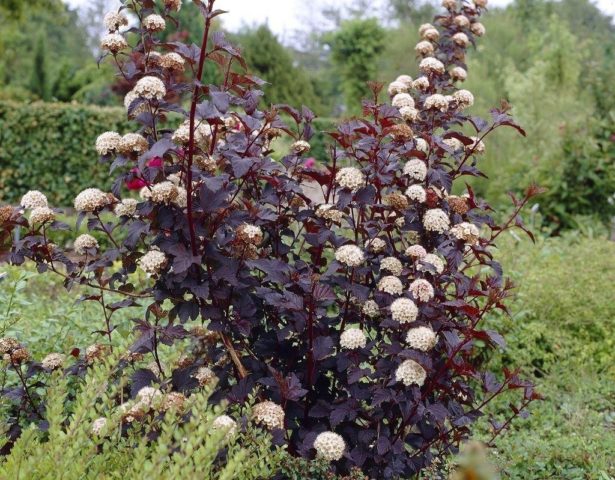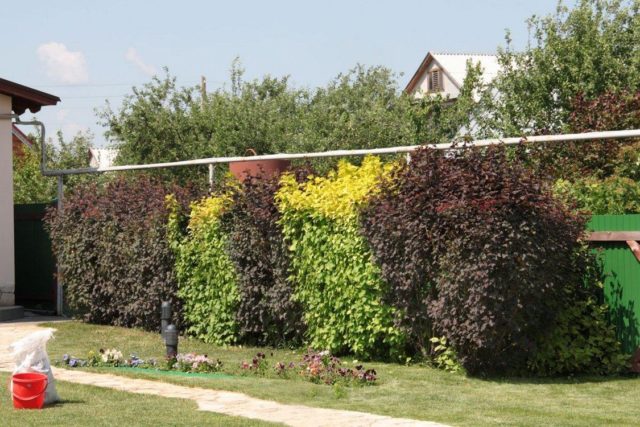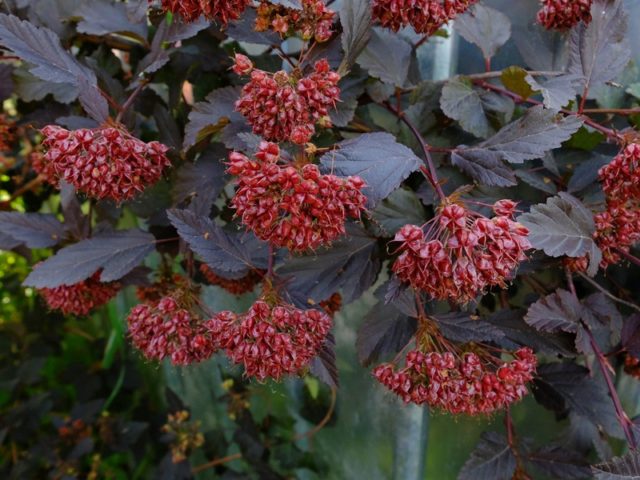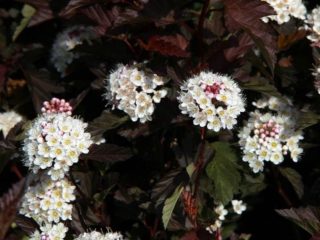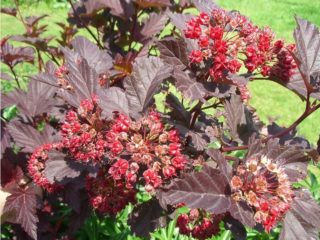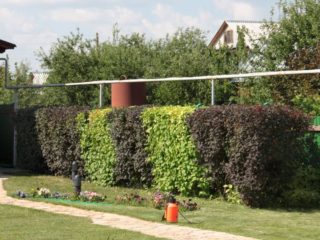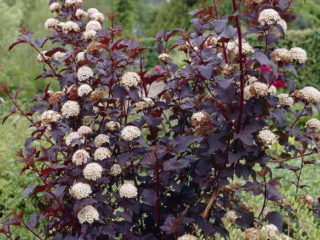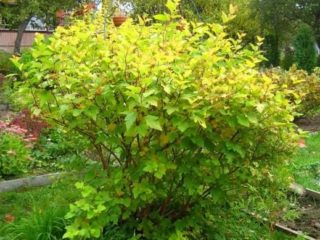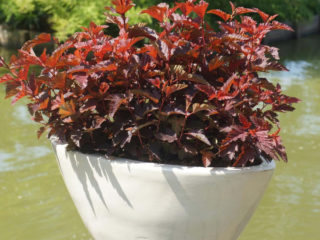Content
Diablo bubble plant is an ornamental plant suitable for growing by novice gardeners. Thanks to the bright color of the leaves, delicate abundant flowers with a pleasant aroma and unusual seeds, the shrub does not lose its attractiveness throughout the growing season, and it is not difficult to care for it.
Description of the bladderwort of the Kalinolistny Diablo
Diablo bladder plant (Physocarpus opulifolius Diabolo) is a fast-growing, flowering shrub with a sprawling, dense crown in the shape of a hemisphere with a diameter of about 3 m.The diablo bladder plant reaches 3 m in height.A year the shrub can grow about 40 - 45 cm.
Leaves are coarsely toothed, with an elongated middle part, consisting of 3-5 lobes. Their shape resembles the shape of a viburnum leaf plate, which is reflected in the name of this variety. Of particular interest is the color of the leaves - depending on the place of growth, they have a different color. So in plants planted in sunny areas, they are dark purple. When grown in the shade, the leaves are green with a slight reddish brown tint. If the sun's rays illuminate the bush unevenly, the color of its crown will also be of different colors.
In June, numerous flowers of a white-pink hue with a diameter of just over 1 cm appear on the bush. Red stamens and a dark yellow core give them a particularly delicate look. The flowers form fluffy inflorescences, 6-8 cm in size. Typically, this variety lasts 2-3 weeks, but sometimes lasts up to two months.
In early autumn, in place of flowers, unusual voluminous fruits ripen, collected in inflorescences. This shrub bears fruit in bolls, leaflets, which have decorative value due to their unusual shape and purple color. They do not lose their attractiveness in winter.
Diablo bubble in landscape design
Due to its decorative qualities, unpretentiousness and insensitivity to urban pollution, the diablo bladder is widely used in landscaping megalopolises. It is planted in courtyards, parks and squares, and serves as a decoration for private gardens. Diablo (pictured) in landscape compositions creates colorful ensembles in which he acts as the main accent. This variety of bladderwort also looks advantageous in single plantings.
Very often, Diablo's vesicle is used as a hedge. A snug fit and proper care provide reliable protection of the territory not only from penetration, but also from prying eyes. If you combine the Diablo variety with other varieties of the bladder, for example, with the Red Baron variety, you can get interesting options for multilevel hedges with different shades of foliage.
Growing conditions for the cultivar Diablo
The diablo bubble plant is characterized by frost resistance, the ability to tolerate air pollution, immunity to diseases and pests, and the rapid growth of the crown. This opens up great opportunities for its successful cultivation in a variety of conditions.
Planting and caring for the diablo bladder
Planting and caring for the diablo bladderwort does not require any special skills from the grower. If you choose the right place and make minimal efforts, the shrub can live up to 40 years, while over time it will not lose its attractive appearance.
Landing site preparation
Bubble plants can grow even in low light conditions, but when grown in an open, sunny area, its foliage takes on an unusual purple color.
The shrub is undemanding to the composition of the soil - it feels equally well on substrates of any type, if they are drained and moderately moist. The best soils for it are fertile sandy loam and loam. The only requirement of the vesicle is the absence of moisture stagnation. If the site is bogged, the bush may die. For the same reason, it is impossible to plant the vesicle in places with a surface occurrence of groundwater.
Landing rules
If a diablo bladder plant is purchased in a container, then it can be planted all season. A plant with an open root system is planted in the spring, before the beginning of the growing season or in late autumn.
Planting Diablo's vesicle is very simple and follows the following algorithm:
- dig a planting hole 2-3 times larger than the size of the root ball;
- soil based on peat or humus is poured onto the bottom with a slide;
- a seedling with an open root system is left in water for 3-5 hours, and then planted;
- container plants are placed in a pit along with an earthen lump, covered with nutritious soil;
- as with planting other shrubs and trees, it is not recommended to deepen the root collar;
- the ground around the seedling is well watered, a root formation stimulator can be added to the water;
- the trunk circle is mulched.
Watering and feeding
Diablo's bubblegum does not tolerate drought well. The frequency of watering depends on several factors. In dry summer and if the shrub grows on loam, it needs watering once every 3-4 days. Clay soil retains moisture well, so it can be watered no more than once a week. Watering is carried out in the morning or evening to avoid sunburn of wet leaves. Newly planted bushes need especially careful watering, since it directly affects their survival rate.
In the spring, manure, bird droppings or weed infusion are added to the water for irrigating the bladder. Ammonium nitrate and urea are also suitable. In autumn, plantings are fed with wood ash dissolved in water. You can also use other mineral fertilizers.
Diablo bladder pruning
Diablo's fast-growing vesicle needs sanitary and formative pruning, especially when used as a hedge. Damaged branches can be removed throughout the season. Formative pruning is done in spring or fall. The bladder plant recovers perfectly after cutting and responds to it with the rapid growth of young shoots.
Preparing for winter
This shrub is extremely frost-hardy and is able to withstand large temperature changes, therefore, only young bushes are sheltered for the winter. Spruce branches are most suitable for this purpose. Adult plants do not need shelter. In severe winters, the tips of the shoots or individual branches may freeze, but this does not affect either the health of the plant or its decorative qualities. The damaged parts are simply cut off during the next sanitary pruning.
Reproduction of the diabolo bladder
You can get new plants of the viburnum bladder Diabolo by forcing from seeds, cuttings, dividing the bush and layering.
Seed propagation is used very rarely, since not all seed material inherits the decorative properties of the mother bush. The main condition for reproduction in this way is seed stratification.
For cuttings at the end of summer, young shoots with several vegetative buds are cut. They are rooted directly in the ground in small greenhouses, protecting from direct sunlight. Nutrient substrate for cuttings is enriched with peat and sand. Cuttings are regularly watered and ventilated. The plantings should be protected from frost with spruce branches. Already in the spring they can be transplanted to a permanent place.
You can propagate the bladder bush by division. This is done in early spring, before sap flow has begun. They dig out a strong developed shrub, separate a part from it along with the root system. The separated plant is placed in a weak solution of potassium permanganate to prevent infection. Separate shrubs are planted in the same way as seedlings purchased from a store or nursery.
To get young bushes with the help of layering, the bark is removed from a strong healthy lower branch, leaving only the upper leaves, then it is fixed in the ground with hooks and added dropwise.
The best time to get cuttings is in spring. Over the summer, the shoots take root, and next spring they can be planted.
Diseases and pests
The diabolo cultivar is highly resistant to diseases and pests. Very rarely, a plant can be affected by chlorosis, the main symptom of which is yellowing of the foliage and drying out of the shoots. The causative agents of this disease are viruses that infect plants growing on highly depleted soils. When applying complex fertilizers, the bladderworm quickly recovers.
Regular care minimizes the likelihood of damage to the plant by diseases and pests.
Conclusion
Diablo's bubble plant is an excellent variety for quickly and easily decorating any part of the garden, creating a romantic corner or growing a reliable hedge. The description of Diablo's vesicle and photo compositions created by amateur gardeners indicate that even a beginner will cope with the task of planting a culture.
